Sam Blond, the former CRO at Brex with 15 years in tech sales, took the stage at SaaStr Europa 2024 to share nine easy sales concepts that so many get wrong. Sam got his first job in tech sales as an SDR for Jason Lemkin’s company, EchoSign, which later sold to Adobe and launched his career.
These nine sales concepts, when done correctly, will greatly improve your sales and sales teams.
[embedded content]
#1: Don’t Outsource Recruiting
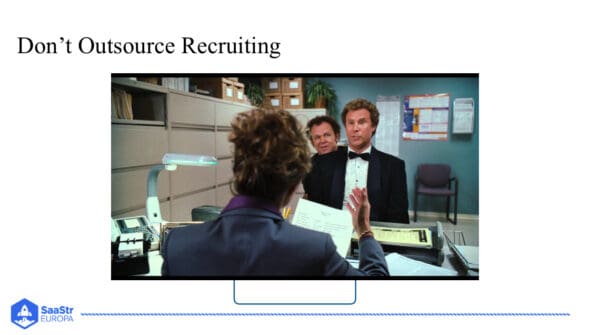

Founders and sales leaders often ask Sam, “Which external recruiting firm do you recommend for sourcing and hiring sales leaders, AEs, or whatever the hire-of-the-day is?” But he doesn’t recommend you leverage external recruiters to source your talent. Founders think outsourcing recruiting will:
- Save them time
- Find them the best candidates
Sam believes both of those things are wrong.
- You don’t end up saving time because you have to interview different firms and onboard them, and you still have to look through resumes, do back-channel references, take calls with them, and more.
- The best candidates don’t really use external recruiters.
The best candidates often go somewhere where their reputation precedes them. They did this right at Brex. When Sam joined, the first two sales reps were referrals from the CFO. The candidates Sam brought in were personal connections.
None of those people will use third-party recruiters, so you end up with a population of strong candidates. There are certainly outliers, but generally, the candidates who join companies as a referral will all be higher performers.
#2: Focus on Demand Until You Have Too Much
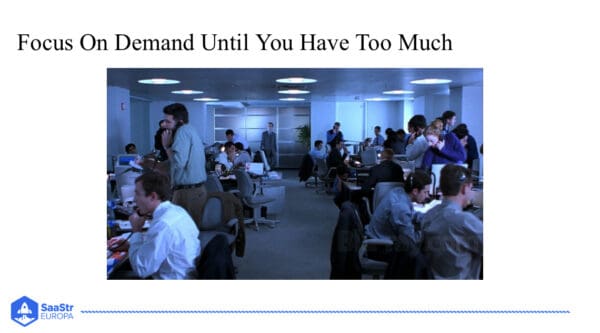

When talking to founders about the performance of the business and where the biggest opportunities exist, seemingly universally, they gravitate towards existing pipeline they’re working or historical pipeline that may or may not have converted.
We’re at the end of Q2, and there is so much emphasis on opportunities in the pipeline you’re trying to close, and the entire performance of Q2 is predicated on whether or not you close those big deals. In a way, you’re diagnosing the biggest opportunities for the business within sales and conversion rates. You’re thinking about opportunities that exist in the pipeline, and that’s a missed opportunity in most cases.
The first question you should ask yourself is, “How many new opportunities were you able to create this week?” The answer is company-specific, determined by your sales cycle, TAM, or how transactional you are, but often, people say they only talked to one or two potential new customers in a week.
Most people think you need to hire more salespeople in a demand-poor environment. That’s the wrong answer. More salespeople often focus on the middle of the funnel, and if you have a limited number of opportunities, yet you add more salespeople, you’re spreading the limited amount of demand to the less tenured people with lower conversion rates.
Demand-poor environments lead to problems like:
- Sales reps clinging on to opportunities for too long.
- Focusing efforts on following up with people who aren’t responding to their emails.
If you focus people on demand instead of the existing funnel, you will produce more revenue for the business than by focusing on the middle of the funnel conversion rates. Almost nothing else matters if you can get these first two concepts right.
Get the right people from a recruiting standpoint, create a demand-rich environment, and many of your problems will dissipate.
#3: Do Things That Stand Out
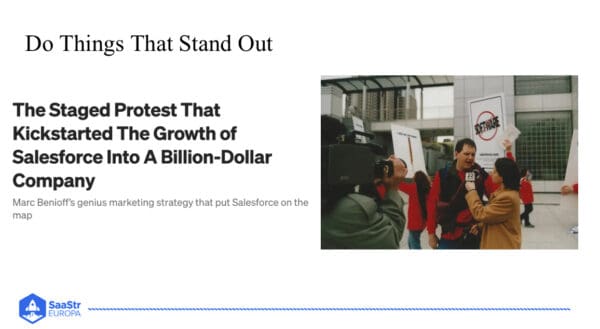

How do you generate demand? By doing things that stand out. So many businesses just go through the motions: sponsoring an event, doing online paid advertising through Google and LinkedIn, and blasting the universe with outbound emails with SDRs.
Things that are truly successful in generating demand are things that very few people or no one else is doing. During Sam’s time at Brex, they had a successful “champagne campaign,” where they sent founders bottles of champagne.
In 2000, Salesforce was an early-stage startup that stood outside a competitor’s conference in San Francisco, staging a fake protest. This received so much attention from conference attendees, who were their direct target market.
One way of measuring the success of a campaign like this, rather than looking at data around SQLs, MQLs, or stage-two opportunities, is to ask what the 2-3 most creative things you as a company have done this quarter to generate demand.
If there’s not an answer, you’re not being creative enough. You should do this reflection at the start of every quarter and get creative with campaigns other people aren’t doing.
#4: Leverage Happy Customers to Generate New Ones
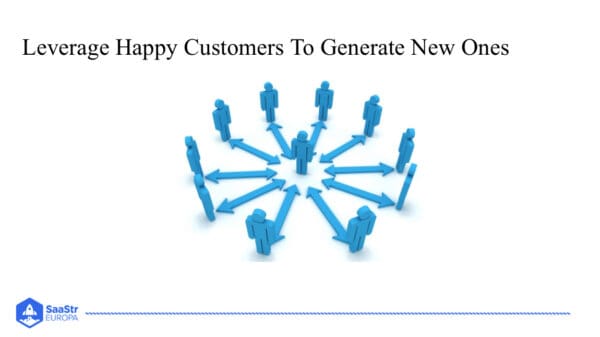

The status quo here is either doing nothing or the bare minimum. There are many opportunities to delight customers, and things start happening organically. They make referrals, and you generate new customers.
Customers will post about their experience on social media and speak positively about you to peers, at conferences, etc. The status quo is to send a thank you email if anything.
You can create magic with this opportunity to go above and beyond for your customers. When someone posts on social media, or something happens where a person goes above and beyond for you, you should reciprocate.
Maybe their favorite team is Manchester United, so you send them an autographed jersey of their best player with a handwritten thank you note. You should do something like this for all your best customers, helping grow your business with referrals.
Think about how many times you’ve been on the receiving end of a gesture like this. When something like that happens, it stands out. So many companies focus on generating new customers by focusing directly on those customers, but you have an army of potential “salespeople” in your happy customer base.
The status quo here is to send a thank you email and not even ask for a referral. You should be spending time, effort, and money leveraging your happy customers to try and generate new ones.
#5: Distribution Is As Important As The Announcement
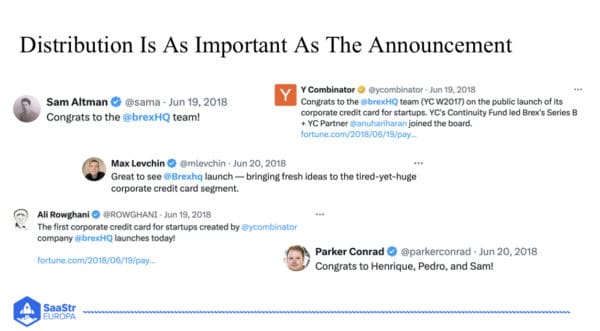

So much effort goes into things like a fundraise, and maybe getting PR around the fundraise. So much effort goes into developing a product for a new product launch. Take Brex, for example; they worked hard to get Brex on a CNBC Disruptor 50 list alongside companies like OpenAI, Stripe, and DataBricks.
So little time and effort is generally placed on distribution, but it’s just as important as the announcement.
At Brex, they created a spreadsheet with about 20 employees at the time. Then, every employee came up with a list of the most influential people in their network and added them to that spreadsheet. For Sam, it was people like Jason Lemkin and Parker Conrad.
Multiply that by 20 people, and you have a pretty long list of folks. On launch day, they reached out to everyone on that list and asked them to tweet, post on LinkedIn, etc. They were everywhere on social that day.
The default is to focus too much on the announcement itself, getting on the list, or developing the product, and less on distribution. As you launch, in addition to focusing efforts on product development itself, focus on the distribution of that announcement to make it more successful.
#6: Be Prescriptive On How To Buy Your Product
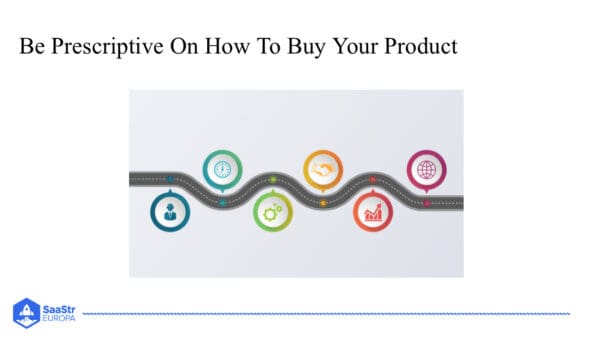

We’re moving down the funnel, which might be more oriented to founders doing founder-led sales and evolving as sales organizations mature. Many early sales reps, leaders, and founders are doing the initial customer acquisition. And the biggest question that comes up is, “How do I sell my product now that I have someone who seems interested?”
They don’t know exactly what to do, are anxious about bringing up pricing, or they’re a founder who has never done sales before. There’s some ambiguity, especially in the early days of customer acquisition.
Sam recommends, from day one, that you be prescriptive on how to buy your product. As you introduce a potential customer to your business and product, you show them the product demo, gauge interest, determine the happy path of onboarding as a customer, etc.
Your customer wants to be educated on how to buy your product. If you don’t know how to buy your product, your customer certainly doesn’t know how to buy your product. So, in the very early days, be prescriptive.
#7: The Presumptive Close
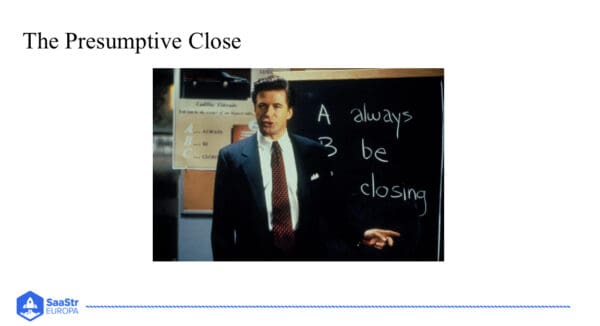

The presumptive close is particularly relevant for businesses with more transactional sales, like an average sales cycle of less than 30 days. It’s also relevant for businesses with a free product or a free trial.
Let’s use Brex as an example. When they did a new customer demo, they’d have an agenda before they began, walk through the product, do a little discovery, design a product demo around their needs and wants, and at the end of the call, they’d walk you through the product application.
Brex is a free corporate card, so this is when they did the presumptive close. You’re actually setting the customer up to walk through the product application so they’re a customer by the end of the call.
It doesn’t work 100% of the time, but it probably increased conversion rates by 2-3x. Because, they were invested in the business after walking through that application. The same is true for businesses with a free trial.
You’re trying to remove as much friction as possible from the sales process and trying to bring the time-to-value as immediate as possible.
#8: Meet Prospective Customers In Person
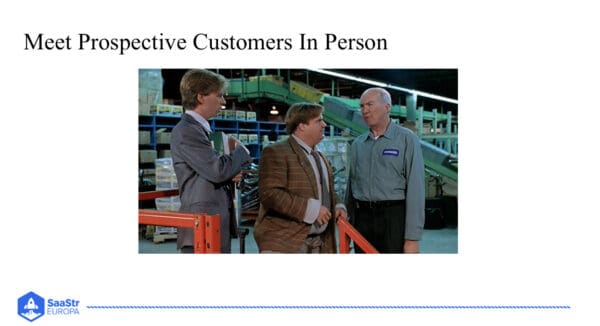

In 2020, most people started working from home and stopped visiting customers in person. We haven’t really returned to meeting prospective customers in person.
At Brex, they measured the conversion rates when people were selling virtually vs. when they met in person. When they met a prospective customer in person, they had a 3x likelihood of closing that customer.
Some calculations need to be done around the size of the opportunity and the convenience of meeting a customer, but you need to do it. So many companies get this wrong today.
If you’re in a competitive deal, most likely, your competitor is not meeting that customer in person. If you can differentiate by meeting that person face-to-face, it signals to them that you’ll go above and beyond as a salesperson, which carries over to your relationship with them as a customer.
Getting on a plane, meeting the customer, taking them to dinner, and improving conversion rates is worth it.
#9: Obsess Over Implementation
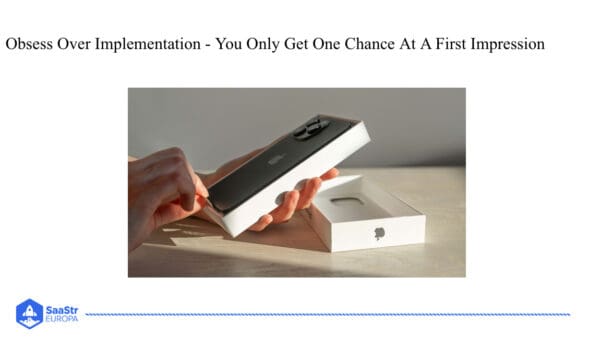

This one is right up there with the first two sales concepts in order of importance. The status quo is something like, “We invest a lot in acquiring new customers and then have hired some CSMs to focus on our customer base. When a sales rep closes a customer, they pass that customer off to the CSM and they own the account indefinitely.”
Some customers that live with that CSM are on their first day, while others are on their 1000th day. A customer on day one has very different needs than a customer on its 1000th day.
So, you should focus on specializing in this concept of implementation, onboarding, or whatever and obsessing over making customers successful. They got this wrong at Brex. A year into the business, they started trying to identify patterns in the customer base—things like lifetime value, churn rates, and customer happiness.
They could tie all these things back to the customer’s experience in their first 30 days. You want customers to leverage specific features and hit certain milestones to make them stickier and more successful.
At Brex, they structured an implementation team focused only on making new customers successful. It was milestone-based, and as soon as they were onboarded through this checklist, they moved to CSM land for ongoing maintenance.
They tried to go back to customers that didn’t meet the milestones, going back 12 months, and it was really hard to resell them on Brex.
You have one point in time where you have the attention of the customer and an opportunity to get them to take actions you believe will make them more successful as a customer. It’s difficult to go back long after the fact and get them to do those things.
Key Takeaways:
- Don’t Outsource Recruiting
- Focus on Demand Until You Have Too Much
- Do Things That Stand Out
- Leverage Happy Customers to Generate New Ones
- Distribution Is As Important As The Announcement
- Be Prescriptive On How To Buy Your Product
- The Presumptive Close
- Meet Prospective Customers In Person
- Obsess Over Implementation
[embedded content]
- SEO Powered Content & PR Distribution. Get Amplified Today.
- PlatoData.Network Vertical Generative Ai. Empower Yourself. Access Here.
- PlatoAiStream. Web3 Intelligence. Knowledge Amplified. Access Here.
- PlatoESG. Carbon, CleanTech, Energy, Environment, Solar, Waste Management. Access Here.
- PlatoHealth. Biotech and Clinical Trials Intelligence. Access Here.
- Source: https://www.saastr.com/9-easy-sales-concepts-so-many-get-wrong-with-sam-blond/



